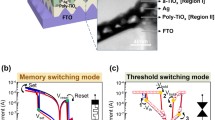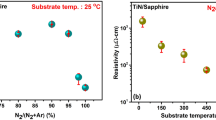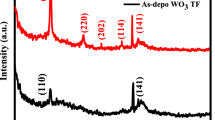Abstract
We present a detailed study of memory performance of titanium oxide (TiO2-x)-based resistive switching memories by modifying critical parameters of the films involved in the memory stack grown by reactive sputtering at room temperature. The device includes a Ti nanolayer at the Au/TiO2-x interface and it is defined by the following material stack: Au/Ti/TiO2-x/Au/SiO2/Si. We investigate the memory performance optimization of the device in terms of the Ti nanolayer thickness using as a starting point for the TiO2-x growth conditions these identified by varying the ratio of oxygen concentration to argon concentration by our previous results. Due to the superb ability of Ti to absorb oxygen atoms from the dielectric matrix, a large amount of oxygen vacancies is created, which are crucial for the stable function of the memory devices. We observe the existence of an optimum Ti thickness that if further increased gradually degrades the resistive switching behavior. The induced interface oxide thickness is found also to affect the fluctuation of the ON/OFF processes. In terms of electrical performance self-rectifying characteristics were recorded for all samples in the both resistance states. We then demonstrate that at least five-level resistance states could be obtained by modifying the compliance current, exhibiting excellent resistance uniformity and retention capability. The results are supported by C-AFM measurements demonstrating the scaling potential of the large area device discussed above.
Similar content being viewed by others
References
G.W. Burr, B.N. Kurdi, J.C. Scott, C.H. Lam, K. Gopalakrishnan, R.S. Shenoy, Overview of candidate device technologies for storage-class memory. IBM J. Res. Dev. 52, (2008) 449.
T.W. Hickmott, Low-frequency negative resistance in thin anodic oxide films. J. Appl. Phys. 33, (1962) 2669.
D. B. Strukov, G. S. Snider, D. R. Stewart, and R. S. Williams, The missing memristor found, Nature 453, (2008) 80.
D.-H. Kwon, K.M. Kim, J.H. Jang, J.M. Jeon, M.H. Lee, G.H. Kim, X.-S. Li, G.-S. Park, B. Lee, S. Han, M. Kim, C.S. Hwang, Atomic structure of conducting nanofilaments in TiO2 resistive switching memory, Nat. Nanotechnology 5, (2010) 148–153.
K. Kamiya, M.Y. Yang, B.M. Köpe, M. Niwa, Y. Nishi, K. Shiraishi, Vacancy cohesion isolation phase transition upon charge injection and removal in binary oxide based RRAM filamentary-type switching, IEEE Trans. Electron Devices 10, (2013) 3400.
P. Bousoulas, I. Michelakaki, D. Tsoukalas, Influence of oxygen content of room temperature TiO2− x deposited films for enhanced resistive switching memory performance, J. Appl. Phys. 115 (2014) 034516.
P. Bousoulas, I. Michelakaki, D. Tsoukalas, Influence of Ti top electrode thickness on the resistive switching properties of forming free and self-rectified TiO2−x thin films, Thin Solid Films 571 (2014) 23–31.
S. Yu, X. Guan, and H.-S. Philip Wong, Conduction mechanism of TiN-HfOx-Pt resistive switching memory: A trap-assisted-tunneling model, Appl. Phys. Lett. 99, (2011) 063507.
T. Gu, Role of oxygen vacancies in TiO2-based resistive switches, J. Appl. Phys. 113 (2013) 033707.
E. Verrelli, D. Tsoukalas, P. Normand, A.H. Kean, N. Boukos, Forming-free resistive switching memories based on titanium-oxide nanoparticles fabricated at room, temperature, Appl. Phys. Lett. 102 (2013) 022909.
S. Stille, Ch. Lenser, R. Dittmann, A. Koehl, I. Krug, R. Muenstermann, J. Perlich, C.M. Schneider, U. Klemradt, R. Waser, Detection of filament formation in forming free resistive switching SrTiO3 devices with Ti top electrodes, Appl. Phys. Lett. 100 (2012) 223503.
M. Lanza, G. Bersuker, M. Porti, E. Miranda, M. Nafría, and X. Aymerich, Resistive switching in hafnium dioxide layers: Local phenomenon at grain boundaries, Appl. Phys. Lett. 101 (2012) 193502.
Acknowledgments
Two of the authors (P. Bousoulas and D. Tsoukalas) would like to acknowledge financial support from research program “Aristeia II” (Grant No. 4543). This research has been co-financed by the European Union (European Social Fund ESF) and Greek national funds through the Operational Program “Education and Lifelong Learning” of the National Strategic Reference Framework (NSRF).
Author information
Authors and Affiliations
Rights and permissions
About this article
Cite this article
Bousoulas, P., Michelakaki, I., Giannopoulos, J. et al. Material and Device Parameters Influencing Multi-Level Resistive Switching of Room Temperature Grown Titanium Oxide Layers. MRS Online Proceedings Library 1729, 59–64 (2014). https://doi.org/10.1557/opl.2015.84
Published:
Issue Date:
DOI: https://doi.org/10.1557/opl.2015.84




